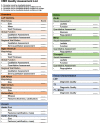The impact of severe obesity on image quality and ventricular function assessment in echocardiography and cardiac MRI
- PMID: 38625629
- PMCID: PMC11147879
- DOI: 10.1007/s10554-024-03078-y
The impact of severe obesity on image quality and ventricular function assessment in echocardiography and cardiac MRI
Abstract
This study sought to evaluate the impact of severe obesity on image quality and ventricular function assessment in cardiovascular magnetic resonance (MRI) and trans-thoracic echocardiography (TTE). We studied 100 consecutive patients who underwent clinically indicated cardiac MRI and TTE studies within 12 months between July 2017 and December 2020; 50 (28 females and 22 males; 54.5 ± 18.7 years) with normal body mass index (BMI) (18.5-25 kg/m2) and 50 (21 females and 29 males; 47.2 ± 13.3 years) with severe obesity (BMI ≥ 40 kg/m2). MRI and TTE image quality scores were compared within and across cohorts using a linear mixed model. Categorical left (LVF) and right (RVF) ventricular function were compared using Cohens Kappa statistic. Mean BMI for normal weight and obese cohorts were 22.2 ± 1.7 kg/m2 and 50.3 ± 5.9 kg/m2, respectively. Out of a possible 93 points, mean MRI image quality score was 91.5 ± 2.5 for patients with normal BMI, and 88.4 ± 5.5 for patients with severe obesity; least square (LS) mean difference 3.1, p = 0.460. TTE scores were 64.2 ± 13.6 for patients with normal BMI and 46.0 ± 12.9 for patients with severe obesity, LS mean difference 18.2, p < 0.001. Ventricular function agreement between modalities was worse in the obese cohort for both LVF (72% vs 80% agreement; kappa 0.53 vs 0.70, obese vs. normal BMI), and RVF (58% vs 72% agreement, kappa 0.18 vs 0.34, obese vs. normal BMI). Severe obesity had limited impact on cardiac MRI image quality, while obesity significantly degraded TTE image quality and ventricular function agreement with MRI.
Keywords: Cardiac MRI; Echocardiography; Image quality; Severe obesity.
© 2024. The Author(s).
Conflict of interest statement
None of the co-authors have any financial associations that might pose a conflict of interest in connection with the submitted article. Dr. Orlando Simonetti receives institutional research support Siemens Medical Solutions; Siemens was not involved in the collection of data or preparation of this manuscript.
Figures






Similar articles
-
Assessment of the accuracy of common clinical thresholds for cardiac morphology and function by transthoracic echocardiography.J Echocardiogr. 2017 Mar;15(1):27-36. doi: 10.1007/s12574-016-0322-4. Epub 2016 Nov 5. J Echocardiogr. 2017. PMID: 27817093
-
Cardiac Structure and Function in Morbidly Obese Parturients: An Echocardiographic Study.Anesth Analg. 2019 Aug;129(2):444-449. doi: 10.1213/ANE.0000000000003554. Anesth Analg. 2019. PMID: 29878938
-
Left Ventricular Hypertrophy and Asymptomatic Cardiac Function Impairment in Chinese Patients with Simple Obesity using Echocardiography.Obes Facts. 2015;8(3):210-9. doi: 10.1159/000435795. Epub 2015 Jun 13. Obes Facts. 2015. PMID: 26087902 Free PMC article.
-
Impaired right ventricular contractile function in childhood obesity and its association with right and left ventricular changes: a cine DENSE cardiac magnetic resonance study.J Cardiovasc Magn Reson. 2017 Jun 28;19(1):49. doi: 10.1186/s12968-017-0363-5. J Cardiovasc Magn Reson. 2017. PMID: 28659144 Free PMC article.
-
Utility of transthoracic echocardiography to estimate severity of right ventricular dysfunction: an MRI comparison study.Int J Cardiovasc Imaging. 2012 Feb;28(2):251-61. doi: 10.1007/s10554-011-9810-9. Epub 2011 Jan 30. Int J Cardiovasc Imaging. 2012. PMID: 21279688
Cited by
-
Feasibility of Noncontrast 3D MR Angiography on a Commercial Wide-Bore 0.55-T System: Comparison with 1.5-T MR Angiography.Radiol Cardiothorac Imaging. 2025 Apr;7(2):e240252. doi: 10.1148/ryct.240252. Radiol Cardiothorac Imaging. 2025. PMID: 40208037
References
-
- Hales CM. Prevalence of obesity and severe obesity among adults: United States. 2017–2018. NCHS Data Brief. 2020;360:1–8. - PubMed
Publication types
MeSH terms
Grants and funding
LinkOut - more resources
Full Text Sources

